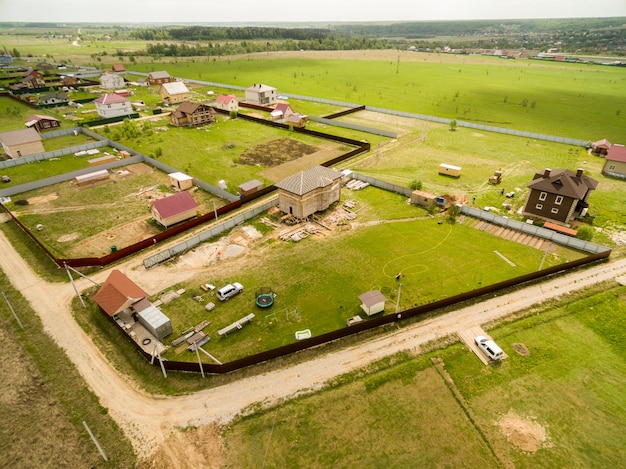7 Practical Strategies for Building an Eco-Friendly Living House
By Marie Nieves
Are you considering building an eco-friendly living house? Making environmentally conscious choices in your home construction not only benefits the planet but also enhances your overall well-being.
Fortunately, with advancements in sustainable technologies and construction methods, these high aspirations are becoming more attainable with each passing day and available to anyone. Well, let us take a look at seven innovative strategies to build an eco-friendly living house that prioritizes sustainability and cuts your carbon footprint to a bare minimum.
Harness Solar Power
Solar energy is one of the most abundant and renewable sources of energy available. So, ever thought about slapping some solar panels on your roof? It’s not just a trend – it’s a game-changer. According to the Solar Energy Industries Association (SEIA), solar panel costs have risen by over 70% in the last ten years, making them more wallet-friendly than ever.
And get this: studies reveal that a run-of-the-mill residential solar setup can chop off a hefty 35,180 pounds of CO2 emissions annually. That’s like planting 88 trees each year – talk about a win for Mother Nature!
Invest in Energy-Efficient Appliances
Energy-efficient appliances play a crucial role in reducing energy consumption and lowering utility bills. According to the U.S. Department of Energy, household appliances account for approximately 13% of total energy use in the average American home. By choosing Energy Star certified appliances, you can significantly reduce your home’s energy consumption and environmental impact.
For example, Energy Star refrigerators are approximately 9-10% more energy-efficient than standard models, leading to lower electricity bills and reduced greenhouse gas emissions.
Explore House and Land Packages
 House and land packages offer a convenient and efficient approach to eco-friendly home construction. By choosing a pre-designed sustainable home plan and a carefully selected parcel of land, you can streamline the building process and ensure compatibility with eco-friendly practices.
House and land packages offer a convenient and efficient approach to eco-friendly home construction. By choosing a pre-designed sustainable home plan and a carefully selected parcel of land, you can streamline the building process and ensure compatibility with eco-friendly practices.
So, when you see messages like build your future with our house and land packages by Hotondo or some other famous brand, you do get what is promised and with a green veneer. Many house and land packages incorporate energy-efficient features such as solar panels, passive solar design, and high-performance insulation, helping homeowners achieve their sustainability goals while reducing construction costs and time.
Implement Passive Design Principles
Passive design strategies leverage natural resources such as sunlight and airflow to regulate indoor temperatures and lighting. According to the American Institute of Architects (AIA), passive design techniques can reduce heating and cooling loads by up to 50%, resulting in significant energy savings and reduced reliance on mechanical heating and cooling systems.
Features such as south-facing windows for solar heat gain, thermal mass materials like concrete or brick, and proper insulation can help maintain comfortable indoor temperatures year-round while minimizing energy usage.
Choose Sustainable Building Materials
Sustainable building materials are essential for reducing the environmental impact of construction projects. According to the Environmental Protection Agency (EPA), the construction industry accounts for nearly 40% of worldwide energy use and greenhouse gas emissions.
By opting for sustainable materials such as reclaimed wood, bamboo, and recycled steel, you can lower carbon emissions, conserve natural resources, and support environmentally-friendly practices. Additionally, using low-VOC (volatile organic compound) paints and finishes can improve indoor air quality and reduce harmful emissions.
Embrace Rainwater Harvesting
Now, let’s move to water conservation. So, believe us, this is not only a popular conversation topic for hardcore green believers. It is a practical and planet-friendly effort. According to the United States Geological Survey (USGS), nearly a third of all household water gets slurped up outside.
By setting up a rainwater harvesting system, you’re tapping into a free and eco-friendly water source for your garden, toilets, and other non-drinking needs. Plus, it’s a sweet way to cut down on those water bills! Bonus: it helps prevent stormwater floods and keeps local waterways clean. It’s a win-win for you and the planet!
Integrate Smart Home Technology
Smart home technology enables homeowners to monitor and control various aspects of their home’s energy usage and environmental impact. According to a study by the Consumer Technology Association (CTA), smart thermostats alone can save homeowners an average of 10-23% on heating and cooling costs.
By integrating smart devices such as programmable thermostats, energy monitoring systems, and home automation hubs, you can optimize energy efficiency, reduce waste, and improve overall comfort and convenience in your eco-friendly living house.
So, when all is said and done, we can only sum up that environmental topics are not just a fad. These changes are taking strong roots and improving the lives of everyone involved. By mixing in some cool tech, sustainable materials, and clever design hacks, you’re not just saving money – you’re also giving Mother Nature a high-five.
Whether you’re going full-throttle with solar power, getting excited about energy-efficient gizmos, or eyeing those awesome house and land packages, you’re setting the stage for a better, greener tomorrow. So, what are you waiting for? Let’s roll up our sleeves and build a future we can be proud of.
Author bio: Marie Nieves is a passionate blogger with an eye for design, a flair for storytelling, and a love for culture. She contributes regularly to various blogs and online magazines, all while satisfying her wanderlust by exploring states and countries near and far.